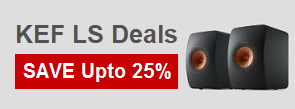Features
| Brand | Elipson |
|---|
Tech Specs
- Type: Center loudspeaker - 2 way - Bass - reflex - Event: Front ported - Tuned Freq. : 62 Hz - Power: 100 W RMS - Haut-parleurs: Mid-Woofers : 2 x 5” Mixed of glass fiber and paper Tweeter : 1” silk dome - Neodynium - Crossover - Fc: 2500 Hz - 12 dB / 12 dB - Frequency Response: (± 3dB) 52 - 25 000 Hz - Recommended Power Amplifier: 30 - 150 W - Sensitivity: 91 dB / 1W / 1m - Impedance: 6 Ohms - Terminal: Single wireProduct Description
Elipson Horus 11F speakers are a 2.5 way design with two 130mm woofers featuring cellulose pulp domes, and a 25mm silk dome tweeter with a neodymium magnet. The woofer domes are fibreglass coated, to increase rigidity and reduce distortion.
These floorstanders have a relatively small footprint of 25 cm x 17.5cm, making them easy to place. Moreover, the front-firing bass ports make positioning less critical. The spiked feet are also removeable.
Three drivers
The Horus 11F has two 130mm bass/midrange units that have a cellulose pulp cone, coated with glass fibre. This helps with rigidity and avoids warping. The tweeter has a 25mm silk dome with a neodymium magnet. Having two bass units gives deeper bass, as does the bigger cabinet. The drivers are well-matched for a cohesive sound. They have a frequency response from 40Hz to 25kHz. That is 15Hz lower, at the bass end of the spectrum than the 6F speakers.
Why two-way speakers?
In the early days of audio, single speakers were fine for the limited frequency range available at the time. However, their limitations became apparent, when trying to reproduce the full frequency range of human hearing. This extends from 20Hz to 20kHz. Although the range rolls off with age.
In the 1940s, cinema sound began to use multiway speakers and this spread to the domestic market. Large speaker cones are not good at reproducing high frequencies which have a shorter wavelength. As a result, two-way speakers use a tweeter unit that has a much smaller dome. This is far more efficient in producing high frequencies.
However, you need a high pass filter, a crossover unit, to block the lower frequencies from getting into the tweeter. This is how most passive two-way speakers are made. Notably, there are other ways of doing this. For example having two amplifiers, one for low and one for high frequencies. In this case, though these two-way hi-fi speakers are easy to drive with a wide range of amplifiers.
Cabinet finish and design
The cabinet of these speakers need to provide a rigid and resonance free mounting for the drivers. Floorstanders also need to be isolated from the floor, to prevent booming. As a result, the 11F comes with removable spiked feet. Three beautiful finishes are available. Black, Light Wood or Walnut. Finally, The front bass ports make it easier to locate the speakers.
Why bass ported?
A bass-ported or bass-reflex speaker will always have more bass than a closed cabinet design. That is because the port allows lower-frequency sounds to escape from the enclosure. This has a significant effect on the bass response. However, bass reflex speakers need careful placement if the port is to the rear, to avoid booming. That is the reason that the 11F has a front-firing port.
Who is Elipson?
Elipson is renowned for its spherical speaker enclosures. They were founded in 1940 and came to fame with the spherical BS50 Chambord speaker. Spherical speakers have no edges to cause refractions. As a result phase shifts are eliminated, giving a cleaner sound. Elipson still produces speakers with spherical elements as well as more conventional speakers, such as the Horus range.
















































































